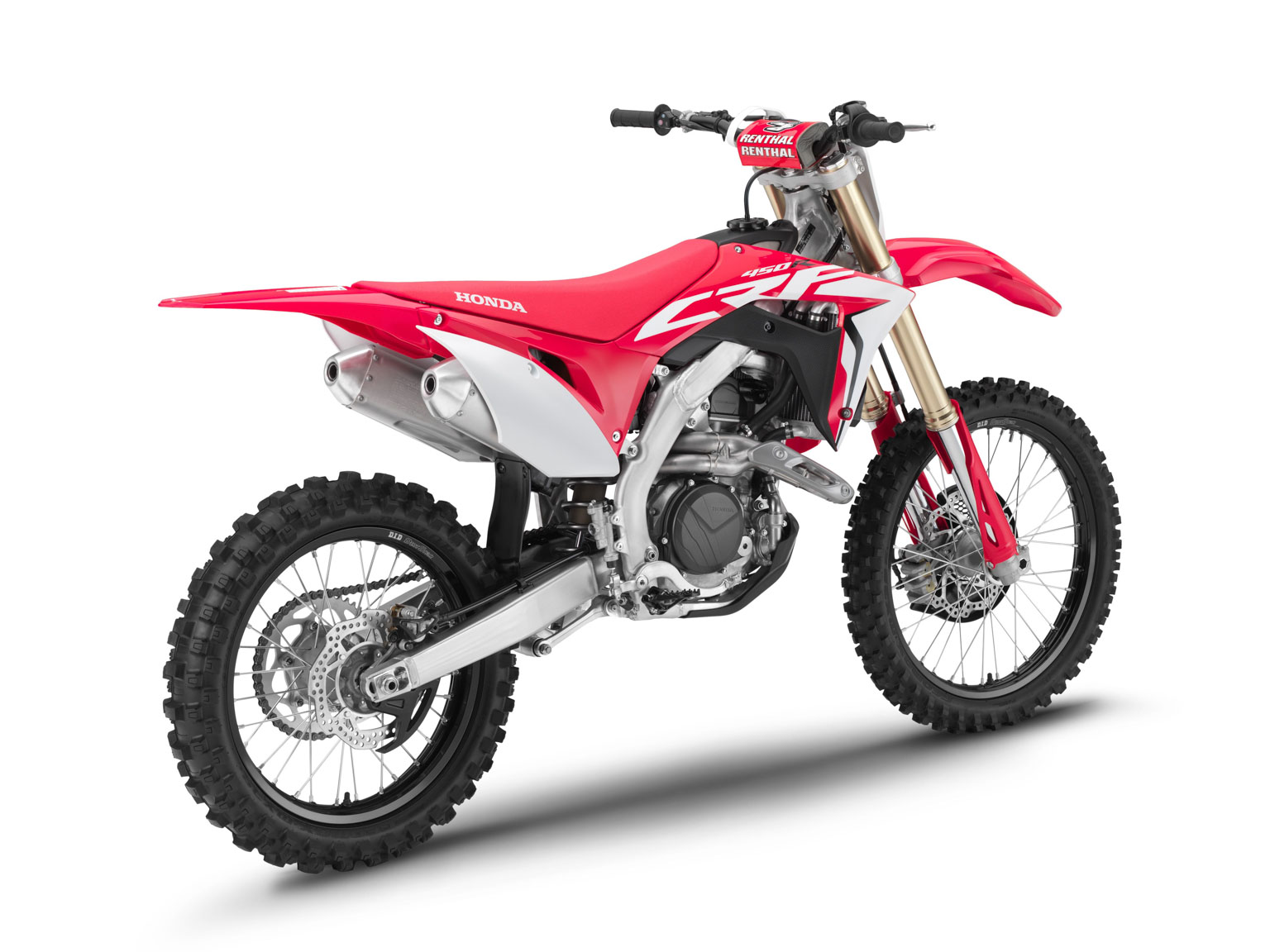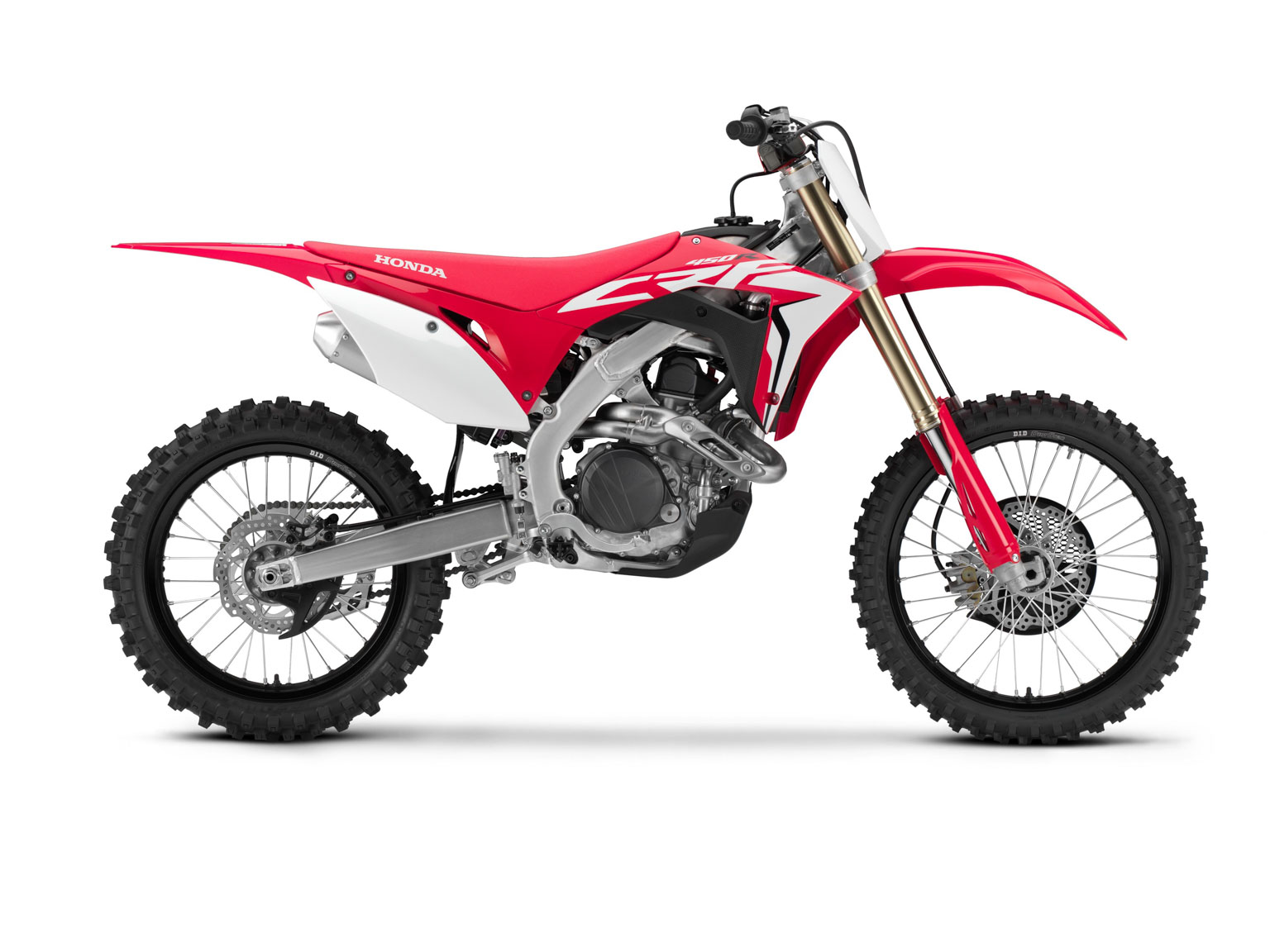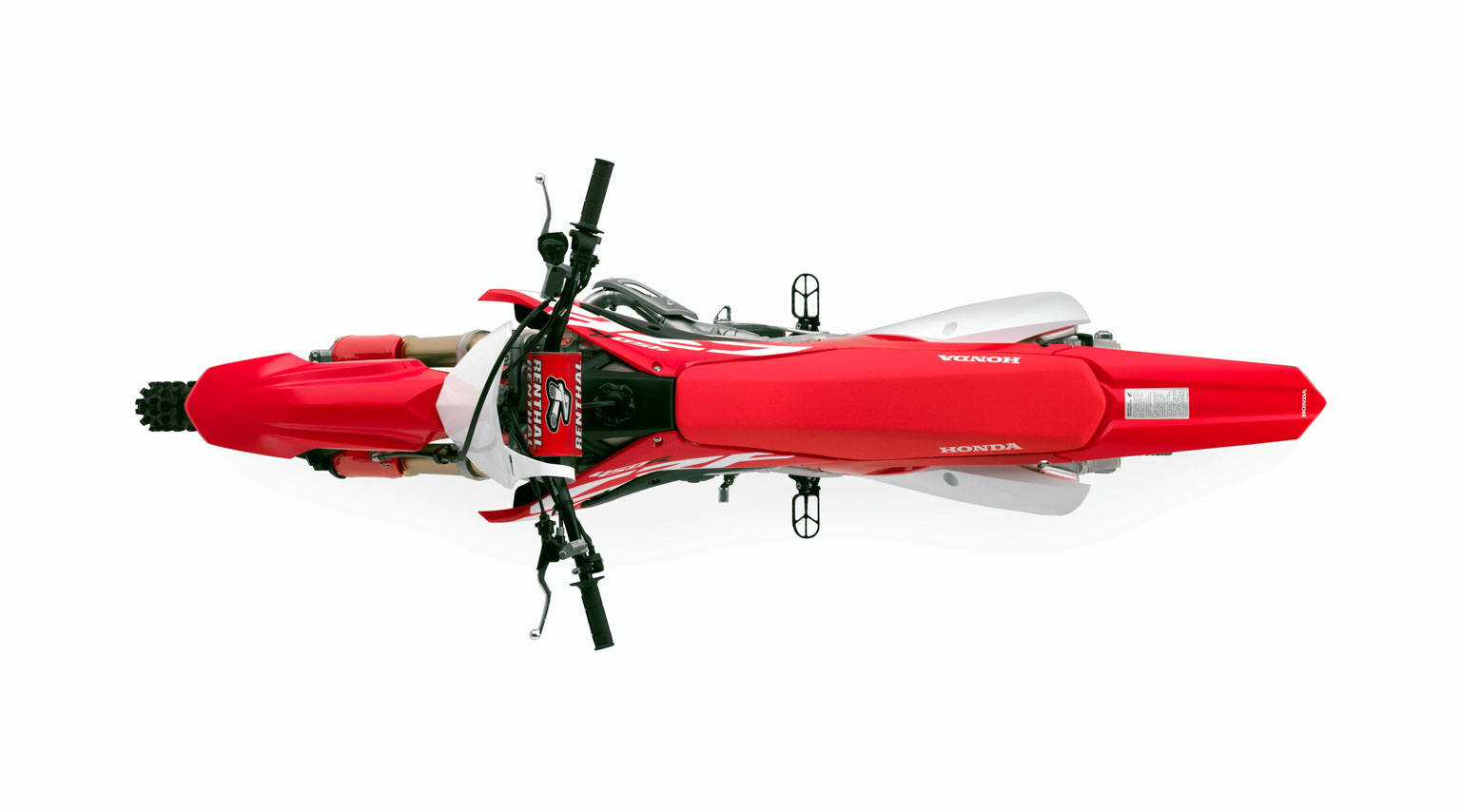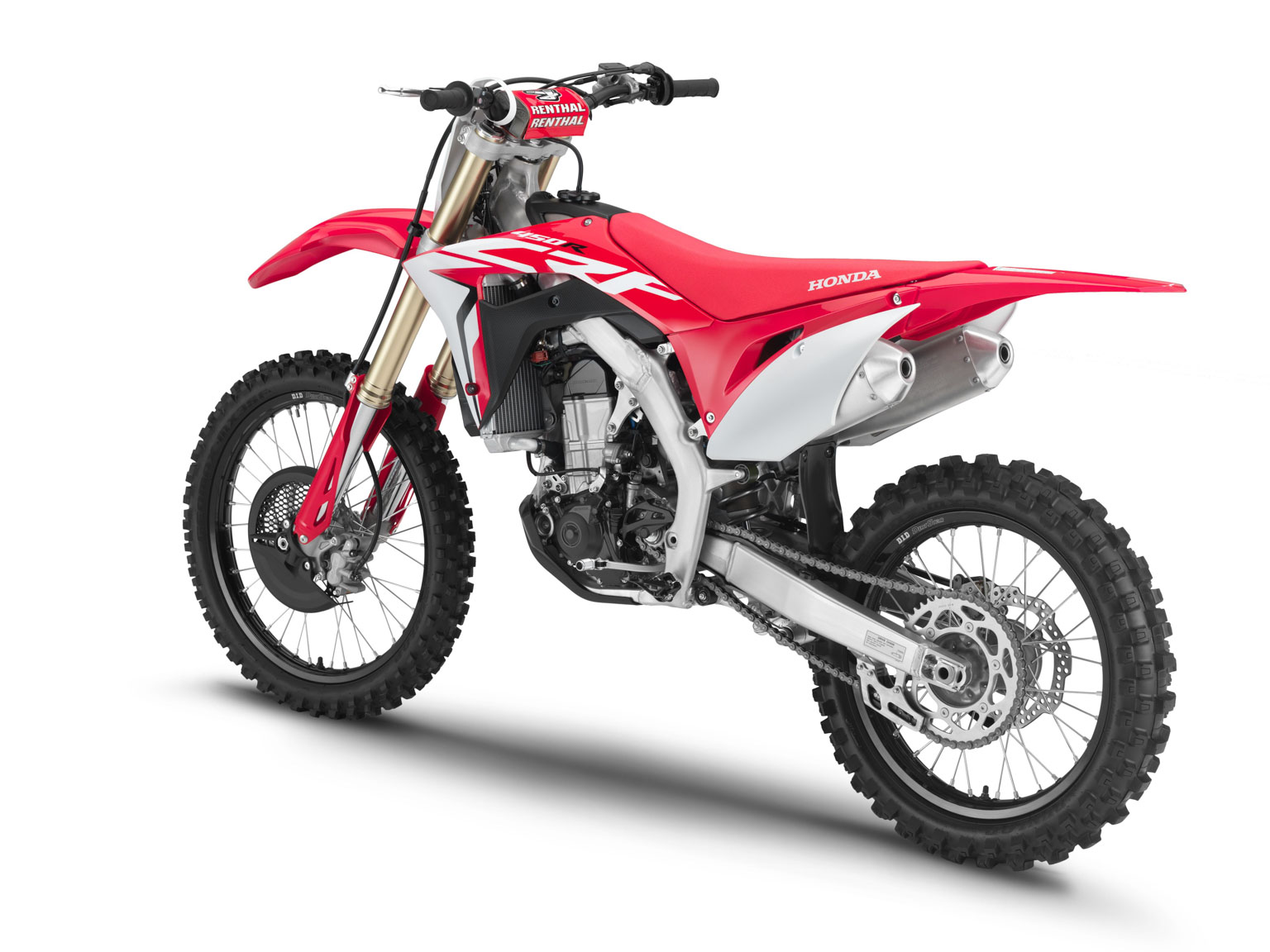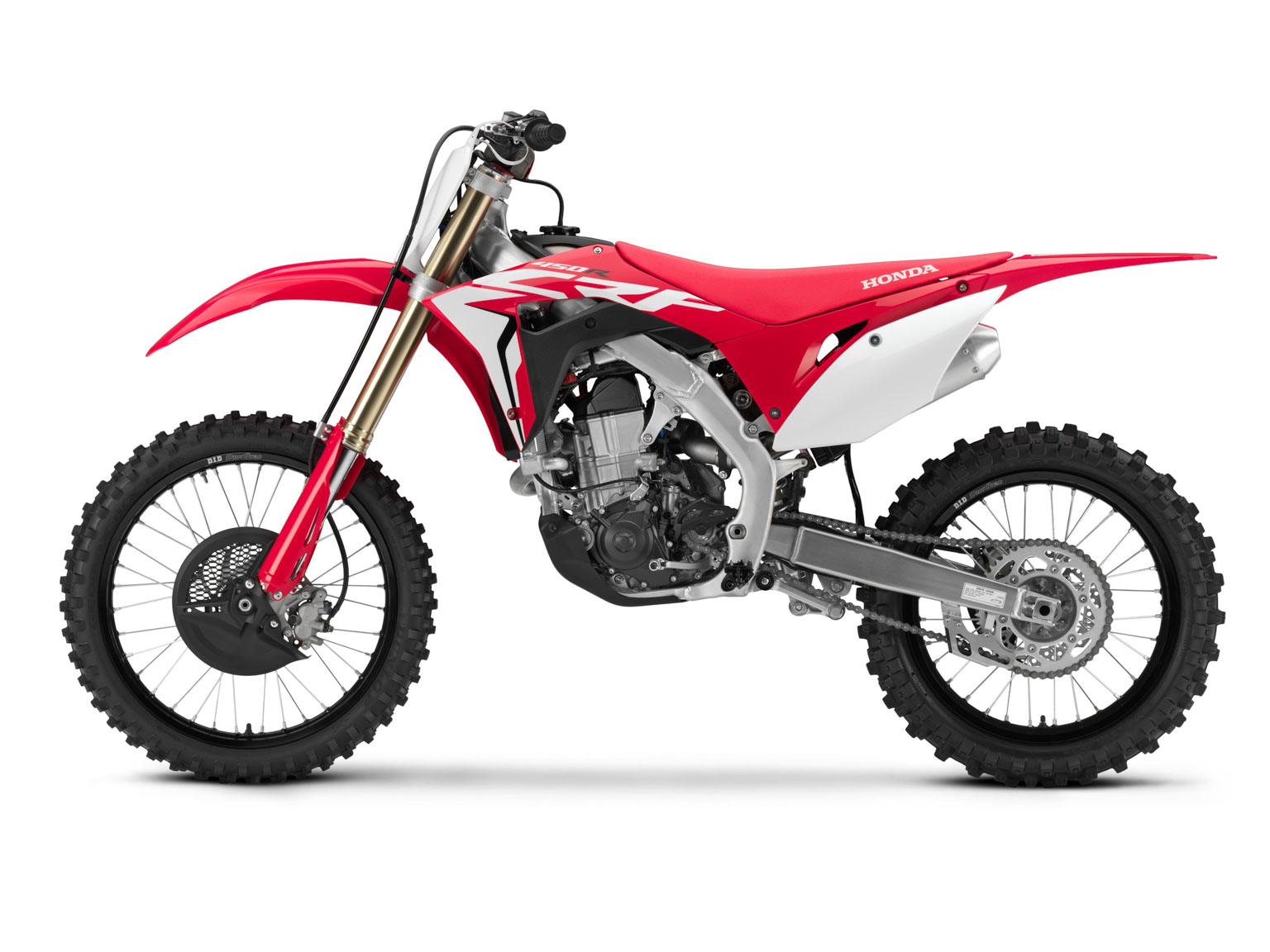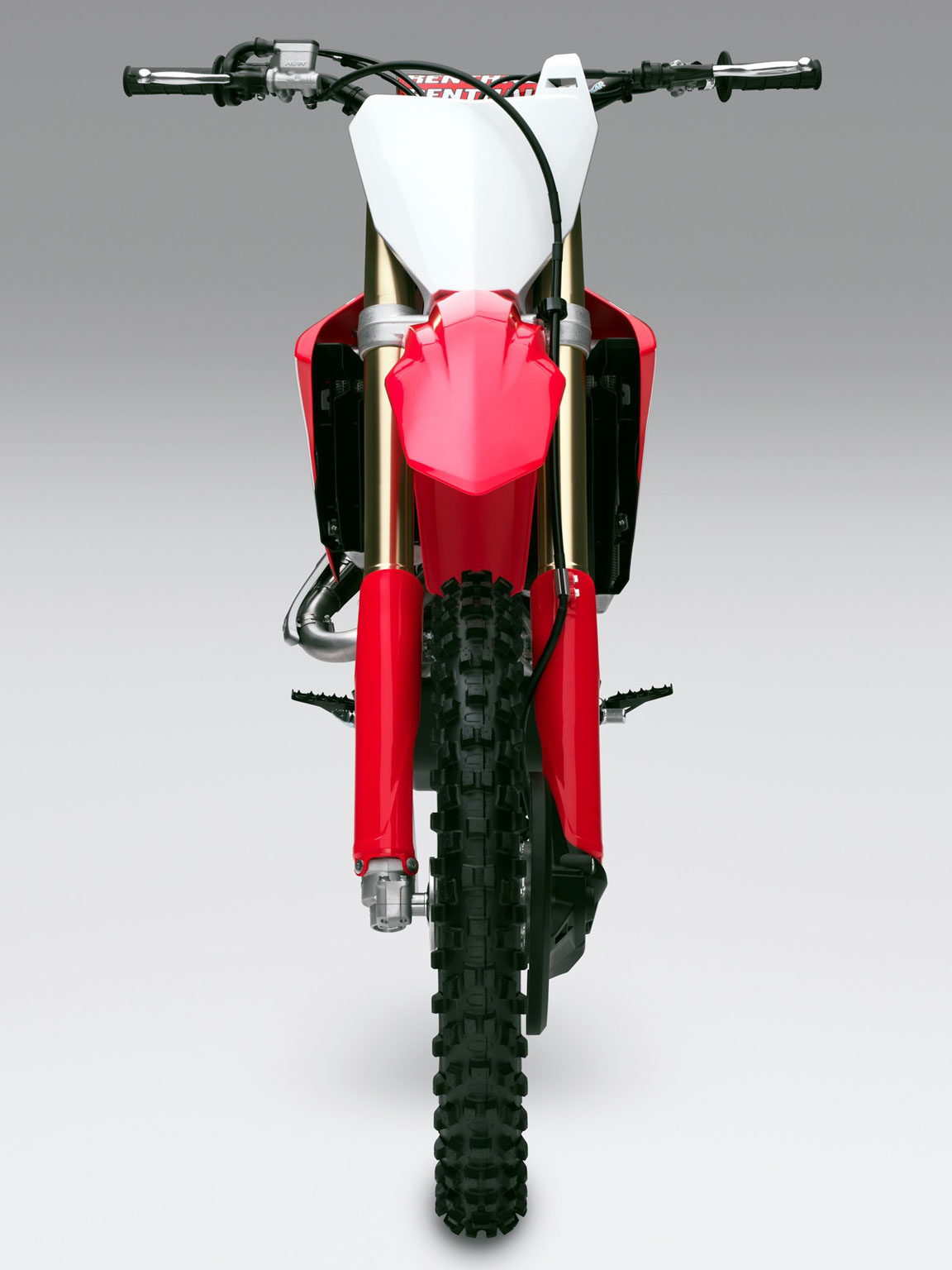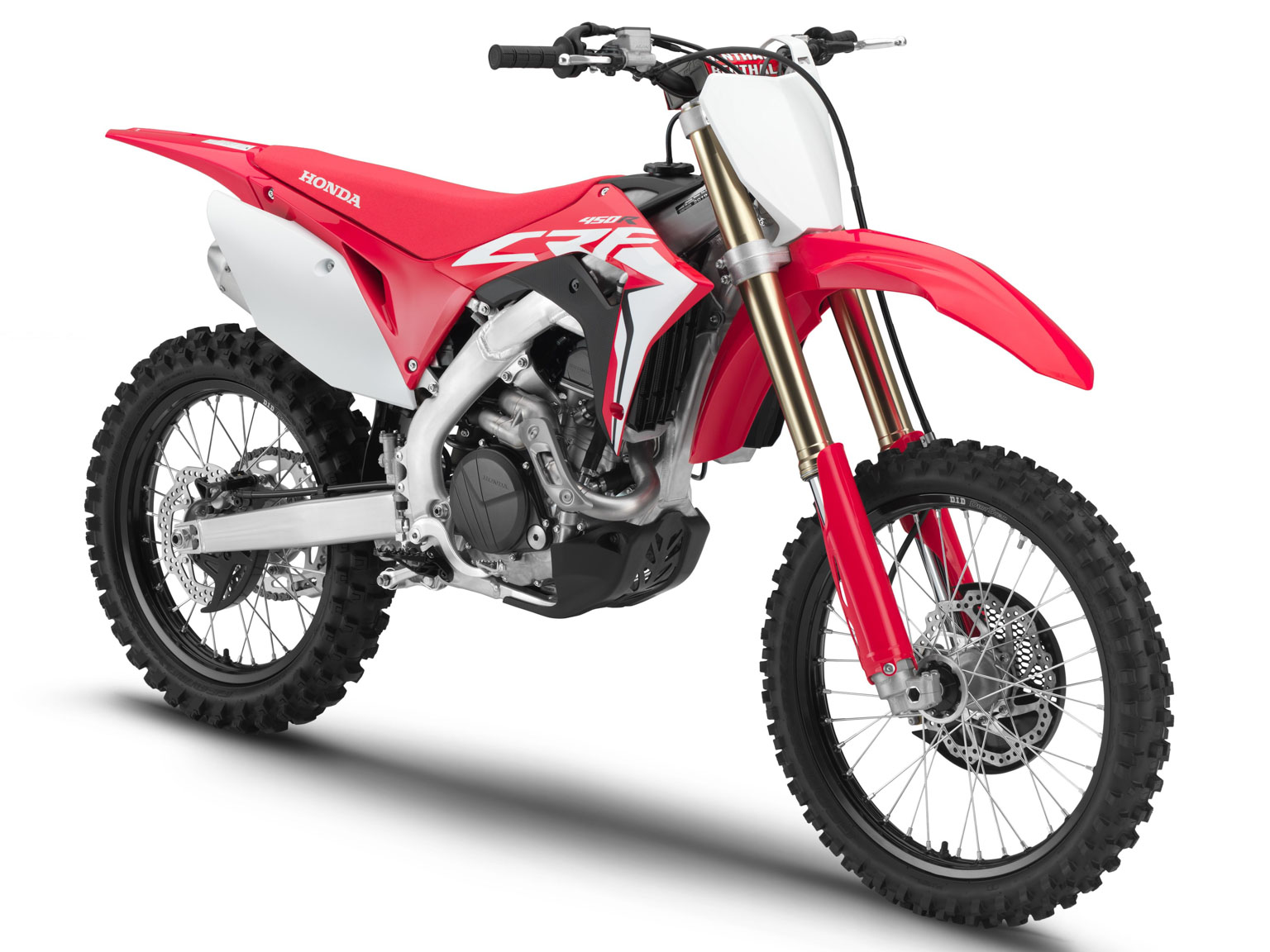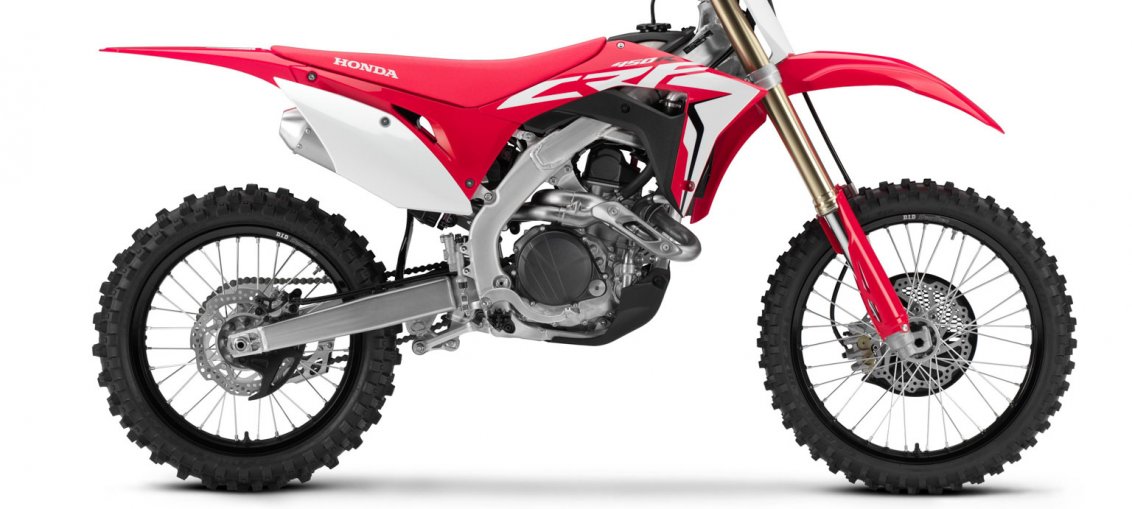
The CRF450R receives a major boost of top-end power and torque, and improved performance throughout the rev-range; it also gets 3-level HRC Launch Control plus durability-focussed upgrades. The chassis features revised suspension settings, detailed weight-saving updates and a new Renthal Fatbar handlebar.
Model updates: The CRF450R receives a major boost of top-end power and torque, and improved performance throughout the rev-range; it also gets 3-level HRC Launch Control plus durability-focussed upgrades. The chassis features revised suspension settings, detailed weight-saving updates and a new Renthal Fatbar handlebar.
- Introduction
The Honda CRF450R has been the moto-crosser to beat since its introduction 2002. It has become a byword for balance and agility, and as such has always offered its rider – whether amateur enthusiast or pro-racer – total control and the chance to get the very best from their ability, plus the durability and longevity that Honda has long been famed for.
And of course the CRF450R has constantly evolved, with every upgrade, large or small, drawing on lessons fed back from Honda’s moto-cross racing programmes throughout the world. For 17YM revolution replaced evolution. Under a total redesign headlined ‘ABSOLUTE HOLESHOT!” Europe’s favourite open-class moto-crosser was effectively a brand-new machine, wielding a major power boost from a brand-new engine, plus increased grip and drive from a completely redesigned chassis.
It looked different from the CRF450Rs that had gone before, felt different and delivered a whole new experience on track. In 18YM the addition of standard-fit electric start (an option for 17YM) completed the package.
But the relentless demands of moto-cross competition mean that, year by year, even the best bikes have to get better, and for 19YM, the CRF450R is getting a straight shot of HRC works technology with major upgrades that make it faster still.
- Model Overview
The ability to punch out of the gate first and build blistering lap times is what the CRF450R has been all about for the last two years. And for 19YM performance rises yet again; considerably more power and torque has been extracted from the engine – via HRC-led tuning of the cylinder head, intake and exhaust – without sacrificing low-rpm tractability.
3-mode HRC Launch Control is an addition, helping any rider from beginner to expert hit the mark from the starting gate every time. A shift sensor enables the use of specific ignition maps for each gear, and PGM-FI has been optimised to inject twice per cycle. Oil pump capacity has been uprated, and the clutch lifter and pressure plate redesigned.
The aluminium twin-spar frame is essentially unchanged but made slightly lighter, as has the swingarm. A new front brake caliper also shaves more vital grams. Revised oil and spring/damping settings for the 49mm Showa USD fork enhance reaction, complemented by a ‘Super Finish’ process for the rear shock’s damper, plus revised Pro-Link ratio.
New Renthal tapered handlebars can also now be adjusted forward/back on the top yoke.
- Key Features
3.1 Engine
- +1.8kW power, +2Nm torque and considerably stronger from 3,000rpm up
- Revised cylinder head, intake and exhaust plus tailored ignition maps
- 3 level HRC Launch Control optimises start performance
- Durability improved with 5-hole piston jet and larger-capacity scavenge pump
While the architecture of the 449cc four-valve Unicam engine remains essentially unchanged – apart from removal of the kick start – a host of detail changes deliver the increase in power and torque.
And while the peak boost is significant – 1.8kW more power at 9,500rpm and 2Nm more torque at 7,500rpm – it has not been achieved at the expense of low-down performance: the strength of the YM19 engine’s power and torque curves from 3,000rpm up are well above the previous design, and corner-to-corner over-rev has also been enhanced.
Bore and stroke remains 96mm x 62.1mm with compression ratio of 13.5:1. Combustion chamber squish has been revised, as has the piston skirt profile, piston ring and conrod; both right and left engine cases have been optimised for strength versus weight.
A new air cleaner element base has more than double the surface area, and flows much more air as a result; revised PGM-F1 settings make use of the improved air flow, and the system now injects fuel twice per cycle. In step with the improved engine output, a revised radiator grill improves air flow for maximum radiator efficiency. A gear position sensor allows the use of three specific ignition maps for 1st and 2nd, 3rd and 4th, and 5th.
The exhaust too now uses differing, larger diameter bores where it splits from the downpipe; 35mm right and 42mm diameter left (both were 31.8mm before). And the total length of the left side exhaust – from port to tip – has been increased 187mm, with the right muffler tube 98mm longer.
It’s not all about performance. Rock-solid reliability has always been a big factor in the CRF450R’s success. A new 5-hole piston oil jet replaces the 4-hole design and the scavenge pump, which used a single, 16mm diameter pickup drum now employs twin 12mm drums, resulting in greater capacity.
The clutch lifter and pressure plate are redesigned for improved durability. Final drive is via 13T front and a re-shaped, lighter 49T rear sprocket.
The rider controls and displays – engine stop button, EFI warning, EMSB mode button and LED indicator – are all in one place on the left handlebar:
New for YM19, HRC’s Launch Control system gives any rider the best option for a strong start and has 3 modes to choose from:
Level 3 – 8,250rpm, muddy conditions/novice
Level 2 – 8,500rpm, dry conditions/basic
Level 1 – 9,500rpm, dry conditions/expert
Activating HRC Launch Control is easy – to turn on, pull in the clutch and push the Start button (on the right). The LED will blink once for Level 1 selection. Push the Start button again, for 0.5s or longer, and the LED will blink twice for Level 2. Repeat the process and the LED will blink 3 times, indication Level 3 has been chosen.
Honda’s EMSB (Engine Mode Select Button) puts instant engine character adaptability at the rider’s control. With the machine stopped, and engine at idle, a simple press and hold of the button for just under a second selects the next map in sequence.
The LED built into the button signals the map in use with a quick press and number of subsequent flashes (like HRC Launch Control, 1 flash for Mode 1, etc). If a new map is selected the choice is also confirmed to the rider.
Mode 1 uses the standard combination of ignition and fuelling maps to present a balanced power and torque delivery. Mode 2 is more mellow in nature, giving easy-to-manage throttle feel. Mode 3 hits sharply, with aggressive and responsive power. Mode 2 and 3 can be further tailored via the existing HRC setting tool for mapping hardware and software.
3.2 Chassis
- Just under 1kg lighter dry weight, frame and swingarm revised in detail
- New settings for 49mm Showa USD fork and rear shock
- Redesigned footpegs and front brake caliper
- Renthal Fat Bars can be adjusted forward/back/up/down
The goal for the seventh generation of CRF aluminium beam frame, debuted in YM17 were clear and defined: improved cornering performance and front-end stability/traction – plus rear wheel drive – while delivering elevated levels of rider feedback and predictability.
And if the focus of YM19 revolves around more power (and its control) from the engine, the CRF450R’s chassis has also improved in step, with even better balance, turning ability and tracking through a corner. 0.9kg has been shaved from the weight figure (dry weight is now 107.6kg, wet weight 112.3kg) while suspension action front and rear has been revised. Rake and trail are set at 27.4°/116mm, with wheelbase of 1482mm.
The tapered twin-spar frame design has been slimmed and lightened around the swingarm pivot plates – the swingarm, too has been subtly re-shaped, is lighter and features a lower rigidity balance to improve traction and feel. The rigidity of the right and left cylinder head hangers has also been optimised. A tiny detail – that also saves 20% weight – are the footpegs, which now use a 4-web (rather than 6) internal structure to clear mud.
The fully adjustable 49mm Showa USD coil spring fork is a version of the Showa ‘factory’ fork supplied to MX race teams in the Japanese championship.
For YM19 spring rate, compression/damping settings and oil weight have been revised. The fully adjustable Showa rear shock has received a ‘Super Finish’ treatment, which improves its stroke action. A revised Pro-Link ratio softens slightly as it reaches full compression.
The new Renthal Fatbar reduces the weight of the steering system and flexes for optimal comfort; the top yoke features two handlebar-holder locations for moving the handlebar rearward and forward by 26mm. When the holder is turned 180 degrees, the handlebar can be moved an additional 10mm from the base position, resulting in four total unique riding positions. A Bar Pad is also included.
A new twin-piston front brake caliper uses 30 and 27mm diameter pistons (the previous design used 2 x 27mm pistons). This allows for a lighter body and, along with low expansion-rate brake hose, improves brake feel and power. It works on a 260mm wave-pattern disc, matched by a rear 240mm wave-pattern disc and single-piston caliper.
Lightweight DID aluminium rims, with directly attached spoke pattern layout are now finished in black; the front is a 21 x 1.6in, the rear a 19 x 2.15in. Fitted as standard equipment are Dunlop’s MX3SF and MX3S soft terrain tyres.
The CRF450R uses a lightweight 6.3L titanium fuel tank. The smooth external lines of the plastics help the rider move easily, and the narrow frontal area and front mudguard directs an efficient funnel of air to the radiator 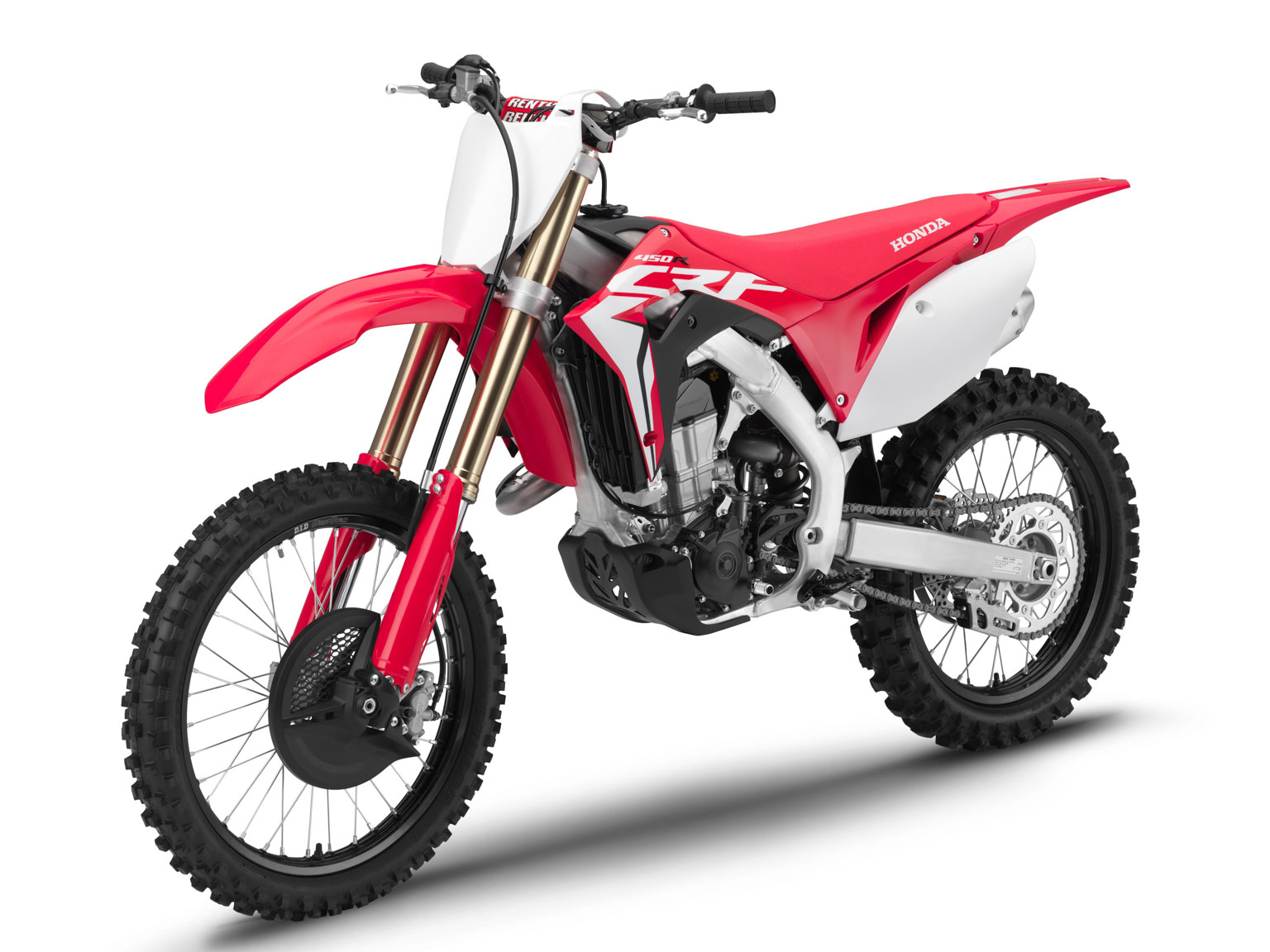
- Technical Specifications
| ENGINE | |
| Type | Liquid-cooled 4-stroke single cylinder uni-cam |
| Displacement | 449.7cc |
| Bore ´ Stroke | 96.0mm x 62.1mm |
| Compression Ratio | 13.5 : 1 |
| FUEL SYSTEM | |
| Carburation | Fuel injection |
| Fuel Tank Capacity | 6.3 litres |
| ELECTRICAL SYSTEM | |
| Ignition | Digital CDI |
| Starter | Self-Starter |
| DRIVETRAIN | |
| Clutch Type | Wet type multi-plate |
| Transmission Type | Constant mesh |
| Final Drive | Chain |
| FRAME | |
| Type | Aluminium twin tube |
| CHASSIS | |
| Dimensions (L´W´H) | 2,183mm x 827mm x 1,260mm |
| Wheelbase | 1,482mm |
| Caster Angle | 27.4° |
| Trail | 116mm |
| Seat Height | 960mm |
| Ground Clearance | 328mm |
| Kerb Weight | 112.3kg |
| SUSPENSION | |
| Type Front | Showa 49mm USD fork |
| Type Rear | Showa monoshock using Honda Pro-Link |
| WHEELS | |
| Type Front | Aluminium spoke |
| Type Rear | Aluminium spoke |
| Tyres Front | 80/100-21-51M Dunlop MX3SF |
| Tyres Rear | 120/80-19-63M Dunlop MX3S |
| BRAKES | |
| Front | Single 260mm disk |
| Rear | Single 240mm disk |

